Farm & Ranch Families Account for Roughly How Much of the Us Population?
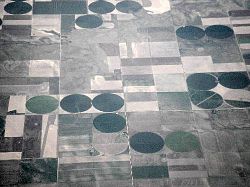
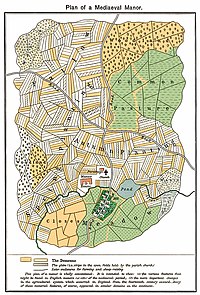
Typical plan of a medieval English language manor, showing the utilise of field strips
A farm (also called an agricultural holding) is an expanse of country that is devoted primarily to agricultural processes with the primary objective of producing food and other crops; it is the bones facility in food product.[1] The name is used for specialized units such as arable farms, vegetable farms, fruit farms, dairy, pig and poultry farms, and land used for the production of natural fiber, biofuel and other commodities. Information technology includes ranches, feedlots, orchards, plantations and estates, smallholdings and hobby farms, and includes the farmhouse and agricultural buildings also as the land. In modern times the term has been extended so as to include such industrial operations as wind farms and fish farms, both of which can operate on land or bounding main.
There are nearly 570 meg farms in the world, with most of which are small and family unit-operated. Small farms with a land area of less than 2 hectares operate near i% of the world's agronomical land, and family farms incorporate about 75% of the world's agricultural land.[2]
Modern farms in developed countries are highly mechanized. In the United States, livestock may exist raised on range, land and finished in feedlots and the mechanization of crop production has brought about a great decrease in the number of agronomical workers needed. In Europe, traditional family unit farms are giving manner to larger production units. In Australia, some farms are very big because the land is unable to support a loftier stocking density of livestock because of climatic conditions. In less developed countries, modest farms are the norm, and the majority of rural residents are subsistence farmers, feeding their families and selling any surplus products in the local market. Acres can concur the crops.
Etymology [edit]

A farmer harvesting crops with mule-drawn wagon, 1920s, Iowa, The states
The discussion in the sense of an agricultural land-holding derives from the verb "to farm" a revenue source, whether taxes, customs, rents of a group of manors or simply to concord an individual manor by the feudal state tenure of "fee farm". The word is from the medieval Latin noun firma, also the source of the French word ferme, meaning a stock-still agreement, contract,[3] from the classical Latin describing word firmus meaning strong, stout, firm.[4] [5] As in the medieval age virtually all manors were engaged in the business of agriculture, which was their principal revenue source, so to hold a manor by the tenure of "fee farm" became synonymous with the do of agronomics itself.
History [edit]
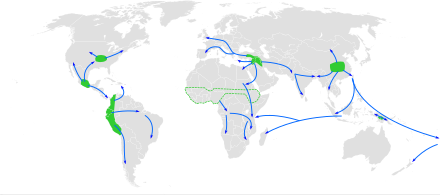
Map of the globe showing approximate centers of origin of agriculture and its spread in prehistory: the Fertile Crescent (11,000 BP), the Yangtze and Xanthous River basins (9,000 BP), and the New Republic of guinea Highlands (9,000–6,000 BP), Central United mexican states (five,000–iv,000 BP), Northern S America (five,000–4,000 BP), sub-Saharan Africa (5,000–4,000 BP, exact location unknown), eastern North America (4,000–3,000 BP).[half-dozen]
Farming has been innovated at multiple dissimilar points and places in man history. The transition from hunter-gatherer to settled, agricultural societies is chosen the Neolithic Revolution and outset began around 12,000 years agone, virtually the starting time of the geological epoch of the Holocene[7] around 12,000 years ago.[8] It was the world'southward first historically verifiable revolution in agronomics. Farming spread from the Centre East to Europe and by 4,000 BC people that lived in the primal part of Europe were using oxen to pull plows and wagons.[9] Subsequent step-changes in human farming practices were provoked by the British Agricultural Revolution in the 18th century, and the Greenish Revolution of the second one-half of the 20th century.
Farming originated independently in different parts of the globe, as hunter gatherer societies transitioned to nutrient production rather than food capture. It may have started about 12,000 years ago with the domestication of livestock in the Fertile Crescent in southwest asia, soon to be followed past the cultivation of crops. Modern units tend to specialize in the crops or livestock all-time suited to the region, with their finished products beingness sold for the retail market or for farther processing, with farm products being traded around the world.
Types of farm [edit]
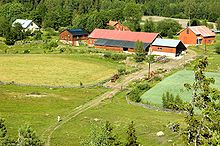
A subcontract may be owned and operated by a single private, family, customs, corporation or a company, may produce 1 or many types of produce, and can be a holding of whatsoever size from a fraction of a hectare[10] to several yard hectares.[11]
A farm may operate nether a monoculture system or with a variety of cereal or abundant crops, which may exist separate from or combined with raising livestock. Specialist farms are often denoted equally such, thus a dairy farm, fish farm, poultry farm or mink subcontract.
Some farms may not use the word at all, hence vineyard (grapes), orchard (nuts and other fruit), market garden or "truck farm" (vegetables and flowers). Some farms may exist denoted by their topographical location, such as a colina farm, while large estates growing cash crops such as cotton wool or coffee may be called plantations.
Many other terms are used to describe farms to denote their methods of production, as in collective, corporate, intensive, organic or vertical.
Other farms may primarily exist for research or teaching, such equally an emmet farm, and since farming is synonymous with mass production, the word "farm" may exist used to describe wind power generation or puppy farm.
Specialized farms [edit]
Dairy subcontract [edit]

Dairy farming is a class of agriculture, where female person cattle, goats, or other mammals are raised for their milk, which may be either candy on-site or transported to a dairy for processing and eventual retail auction There are many breeds of cattle that can be milked some of the best producing ones include Holstein, Norwegian Ruby-red, Kostroma, Brown Swiss, and more.[12]
In most Western countries, a centralized dairy facility processes milk and dairy products, such as cream, butter, and cheese. In the Us, these dairies are normally local companies, while in the southern hemisphere facilities may exist run by very large nationwide or trans-national corporations (such as Fonterra).
Dairy farms generally sell male calves for veal meat, as dairy breeds are not normally satisfactory for commercial beef product. Many dairy farms also grow their own feed, typically including corn, alfalfa, and hay. This is fed directly to the cows, or stored every bit silage for use during the winter season. Additional dietary supplements are added to the feed to better milk production. [13]
Poultry farm [edit]

Poultry farms are devoted to raising chickens (egg layers or broilers), turkeys, ducks, and other fowl, generally for meat or eggs.[14]
Sus scrofa farm [edit]
A sus scrofa farm is 1 that specializes in raising pigs or hogs for bacon, ham and other pork products. They may be costless range, intensive, or both.
Ownership [edit]
Farm control and ownership has traditionally been a key indicator of status and ability, especially in Medieval European agrarian societies. The distribution of farm buying has historically been closely linked to grade of government. Medieval feudalism was essentially a system that centralized command of farmland, control of farm labor and political power, while the early American commonwealth, in which state ownership was a prerequisite for voting rights, was built on relatively easy paths to individual subcontract ownership. Notwithstanding, the gradual modernization and mechanization of farming, which greatly increases both the efficiency and capital requirements of farming, has led to increasingly large farms. This has usually been accompanied by the decoupling of political power from farm ownership.[ citation needed ]
Forms of ownership [edit]
In some societies (especially socialist and communist), collective farming is the norm, with either government ownership of the land or mutual ownership by a local group. Especially in societies without widespread industrialized farming, tenant farming and sharecropping are common; farmers either pay landowners for the correct to use farmland or give up a portion of the crops.
Agribusiness [edit]
Agribusiness (likewise called bio-business[15] [16] or bio-enterprise) refers to the enterprises, the industry, the system, and the field of study of the interrelated and interdependent[17] value chains in agronomics[eighteen] and bio-economy.[19] The primary goal of agribusiness is to maximize turn a profit while sustainably satisfying the needs of consumers for products related to natural resources such as biotechnology, farms, nutrient, forestry, fisheries, fuel, and fiber — usually with the exclusion of non-renewable resources such as mining.[20] [21]
Studies of business organisation growth and performance in farming have plant successful agricultural businesses are toll-efficient internally and operate in favorable economic, political, and physical-organic environments. They are able to expand and make profits, improve the productivity of land, labor, and capital, and keep their costs downward to ensure market cost competitiveness.[22]
Agribusiness is not limited to farming. Information technology encompasses a broader spectrum through the agribusiness system which includes input supplies, value-improver, marketing, entrepreneurship, microfinancing, agricultural extension, amid others.
In some countries similar the Philippines, creation and management of agribusiness enterprises crave consultation with registered agriculturists if reached a certain level of operations, capitalization, country area, or number of animals in the farm.
Farms effectually the globe [edit]

Americas [edit]
The state and buildings of a farm are chosen the "farmstead".[23] Enterprises where livestock are raised on rangeland are called ranches. Where livestock are raised in confinement on feed produced elsewhere, the term feedlot is normally used.
In the Us, in 1910 in that location were 6,406,000 farms and 10,174,000 family unit workers; In 2000 there were only 2,172,000 farms and 2,062,300 family workers.[24] The share of U.Southward. farms operated by women has risen steadily over contempo decades, from v percentage in 1978 to xiv pct past 2007.[25]
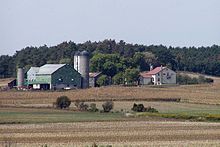
A typical N American grain farm with farmstead in Ontario, Canada
In the U.s., there are over iii million migrant and seasonal farmworkers; 72% are foreign-born, 78% are male, they have an boilerplate age of 36 and average education of 8 years.[26] Farmworkers make an average hourly rate of $9–10 per hour, compared to an average of over $18 per 60 minutes for nonfarm labor. Their average family income is nether $20,000 and 23% live in families with incomes beneath the federal poverty level.[27] One-half of all farmworker families earn less than $x,000 per year,[28] which is significantly below the 2005 U.S. poverty level of $19,874 for a family unit of 4.
In 2007, corn acres are expected to increment by xv% because of the high demand for ethanol, both in and exterior of the U.South. Producers are expecting to establish 90.5 1000000 acres (366,000 kmii) of corn, making information technology the largest corn ingather since 1944.[29]

Traditional Dutch farmhouse
Europe [edit]
In the United kingdom of great britain and northern ireland, farm equally an agricultural unit, always denotes the area of pasture and other fields together with its farmhouse, farmyard and outbuildings. Big farms, or groups of farms under the aforementioned ownership, may be called an estate. Conversely, a small farm surrounding the possessor's dwelling is called a smallholding and is mostly focused on self-sufficiency with simply the surplus being sold.
In Europe, traditional family unit farms are giving way to larger production units where industrial agriculture and mechanization brings brings large crop yields.[9]
The Common agricultural policy (CAP) is ane of the near important policies of the European union and is helping in the change of farms from traditional family farms to larger production units. The policy has the objectives of increasing agricultural production, providing certainty in food supplies, ensuring a loftier quality of life for farmers, stabilizing markets, and ensuring reasonable prices for consumers.[xxx] Information technology was, until recently, operated by a system of subsidies and marketplace intervention. Until the 1990s, the policy accounted for over 60 per cent of the European Union's annual budget, and as of 2013 accounts for effectually 34 per cent.[31]
Asia [edit]
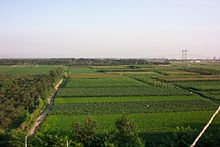
Pakistan [edit]
Co-ordinate to the World Depository financial institution, "well-nigh empirical show indicates that land productivity on large farms in Pakistan is lower than that of small farms, holding other factors constant." Small farmers accept "college internet returns per hectare" than big farms, according to farm household income data.[32]
Nepal [edit]

Nepal is an agricultural country and nearly 80% of the total population are engaged in farming. Rice is mainly produced in Nepal along with fruits like apples.[33] Dairy farming and poultry farming are also growing in Nepal.
Commonwealth of australia [edit]


Farming is a significant economic sector in Australia. A farm is an area of land used for primary production which will include buildings.
According to the UN, "green agriculture directs a greater share of total farming input expenditures towards the purchase of locally sourced input?(e.g. labour and organic fertilisers) and a local multiplier upshot is expected to kick in. Overall, green farming practices tend to require more labour inputs than conventional farming (e.yard. from comparable levels to every bit much as thirty per cent more) (FAO 2007 and European Commission 2010), creating jobs in rural areas and a higher return on labour inputs."[34]
Where most of the income is from some other employment, and the subcontract is really an expanded residence, the term hobby farm is common. This will allow sufficient size for recreational use but be very unlikely to produce sufficient income to be self-sustaining. Hobby farms are normally around 2 hectares (four.9 acres) but may be much larger depending upon land prices (which vary regionally).
Often very pocket-size farms used for intensive primary production are referred to by the specialization they are existence used for, such as a dairy rather than a dairy farm, a piggery, a market garden, etc. This also applies to feedlots, which are specifically developed to a unmarried purpose and are ofttimes non able to exist used for more than general purpose (mixed) farming practices.
In remote areas farms can become quite large. As with estates in England, there is no divers size or method of functioning at which a big farm becomes a station.
Africa [edit]
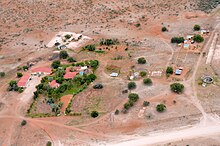
A farm in Africa includes various structures. Depending on climate-related areas primarily farming is the raising and convenance of grazing livestock, such equally cattle, sheep, ostriches, horses or goats. Predominantly domestic animals are raised for their meat, milk, skin, leather or fiber (wool). Y'all might fifty-fifty come up across silk farms.[35]
Furthermore, there are enough of hunting farms, guest farms and game farms. Arable or irrigated land is ofttimes used for raising crops such as feed grains and hay for animal feeding.
On some farms (Astro Farm) star-gazing became very popular because of the excellent optical quality in the desert.[36] The High Free energy Stereoscopic System (H.E.S.S.) which investigates cosmic gamma rays is situated on Farm Göllschau in Namibia.
Farm equipment [edit]
Farm equipment has evolved over the centuries from simple mitt tools such as the hoe, through ox- or horse-drawn equipment such as the plough and harrow, to the modern highly technical machinery such as the tractor, baler and combine harvester replacing what was a highly labour-intensive occupation before the Industrial revolution. Today much of the farm equipment used on both small[37] and large farms is automated (e.1000. using satellite guided farming).[38]
Equally new types of high-tech subcontract equipment have get inaccessible to farmers that historically fixed their own equipment, Wired reports there is a growing backlash,[39] due mostly to companies using intellectual property law to forestall farmers from having the legal right to fix their equipment (or gain admission to the data to allow them to do it).[40] This has encouraged groups such as Open Source Environmental and Farm Hack[41] to begin to make open source hardware for agricultural equipment. In add-on on a smaller calibration Farmbot[42] and the RepRap open up source 3D printer customs has begun to make open-source farm tools available of increasing levels of sophistication.[43]
Run into also [edit]
- Agrarian construction
- Agricultural ecology
- Electrical energy efficiency on United States farms
- Manufactory farming
- Gentleman'south farm
- Hobby farm
- List of organic gardening and farming topics
- Museum of Scottish Country Life
- Prison farm
- Ranch
- Rural
- Rural economics
- Rural flight
- Smallholding
References [edit]
- ^ Gregor, 209; Adams, 454.
- ^ Lowder, Sarah K.; Skoet, Jakob; Raney, Terri (2016). "The Number, Size, and Distribution of Farms, Smallholder Farms, and Family Farms Worldwide". World Development. 87: 16–29. doi:x.1016/j.worlddev.2015.ten.041.
- ^ Larousse Dictionnaire de la Langue Francaise Lexis, Paris, 1993
- ^ Patrick Hanks, ed. (1986). Collins dictionary of the English language language. London: Collins. Bibcode:1986cdel.book.....H.
- ^ James Robert Vernam Marchant, Joseph Fletcher Charles (ed.). Cassell's Latin dictionary. Funk & Wagnalls.
- ^ Diamond, J.; Bellwood, P. (2003). "Farmers and Their Languages: The Start Expansions" (PDF). Science. 300 (5619): 597–603. Bibcode:2003Sci...300..597D. CiteSeerX10.1.1.1013.4523. doi:10.1126/science.1078208. PMID 12714734. S2CID 13350469.
- ^ "International Stratigraphic Chart". International Commission on Stratigraphy. Archived from the original on 2013-02-12. Retrieved 2012-12-06 .
- ^ Graeme Barker (25 March 2009). The Agronomical Revolution in Prehistory: Why did Foragers go Farmers?. Oxford Academy Press. ISBN978-0-xix-955995-4 . Retrieved 15 August 2012.
- ^ a b "A History of Farming". www.localhistories.org . Retrieved 2016-04-04 .
- ^ Winterbottom, Jo; Jadhav, Rajendra (June 20, 2011). "SPECIAL Study - Republic of india's food chain in deep change". Reuters . Retrieved 12 July 2011.
The average size of farms in India is a mere 1.77 hectares -- well-nigh the size of 2 soccer pitches
- ^ "Anna Creek Station". Wrightsair. Archived from the original on March 1, 2008. Retrieved February 17, 2012.
Anna Creek Station is well known equally the largest cattle station in the world, covering an area of 24,000 sq. km
- ^ "Top Xviii Best Milk Producing Cattle Breeds in the World". farm-animals.knoji.com . Retrieved 2016-04-04 .
- ^ "ThinkQuest". Archived from the original on 25 October 2012. Retrieved 26 October 2014.
- ^ "A Beginner's Guide to Poultry Farming". The Alabama Poultry and Egg Association. Archived from the original on February 25, 2012. Retrieved Feb xviii, 2012.
- ^ Heijman, Wim (2016-06-01). "How big is the bio-business? Notes on measuring the size of the Dutch bio-economy". NJAS - Wageningen Journal of Life Sciences. 77: v–8. doi:ten.1016/j.njas.2016.03.004. ISSN 1573-5214. S2CID 156714858.
- ^ "Curriculum|TOKYO Academy OF Agronomics". www.nodai.air conditioning.jp . Retrieved 2021-05-02 .
- ^ Ward, Natalee (2017-05-25). "Ray Goldberg: The man that coined the term "agribusiness"". www.weeklytimesnow.com.au. Archived from the original on 2021-05-02. Retrieved 2021-05-02 .
- ^ Ng, Desmond; Siebert, John Due west. (2009). "Toward Better Defining the Field of Agribusiness Direction" (PDF). International Food and Agribusiness Management Review. 12 (4).
- ^ Adamowicz, Mieczysław (2020). "Bioeconomy As a Concept for The Evolution of Agriculture and Agribusiness". Problems of Agronomical Economics. 365: 135–155. doi:10.30858/zer/131842. ISSN 0044-1600. S2CID 234433508.
- ^ "The Growing Battle between Mining and Agriculture". politicsofpoverty.oxfamamerica.org . Retrieved 2021-05-02 .
- ^ "Reframing Agribusiness: Moving from Farm to Market Centric | Request PDF". ResearchGate . Retrieved 2021-05-04 .
- ^ "Agronomical businesses: Central influences on growth and performance", in Agronomical Businesses: Their Growth & Performance, ISR/Google Books, 2022. ISBN 9780906321782
- ^ "Definition of FARMSTEAD". www.merriam-webster.com . Retrieved 2021-06-15 .
- ^ "National Agronomical Statistics Service". Archived from the original on 2007-07-15. Retrieved 2007-04-xx .
- ^ Hoppe, Robert A. and Penni Korb. (2013). Characteristics of Women Farm Operators and Their Farms. Washington, D.C.: U.Southward. Department of Agriculture, Economic Research Service.
- ^ "Facts well-nigh Farmworkers" (PDF). National Middle for Farmworker Wellness. Archived from the original (PDF) on May sixteen, 2013. Retrieved March 29, 2013.
- ^ "Changing Characteristics of U.S. Farm Workers" (PDF). U.S. Department of Labor. Archived from the original (PDF) on February 6, 2013. Retrieved March 29, 2013.
- ^ "Facts on Farmworkers in the United States" (PDF). Cornell Academy. 2001. Archived from the original (PDF) on December 7, 2006. Retrieved February 17, 2012.
- ^ "Corn Acres Expected to Soar in 2007, USDA Says". Newsroom. Washington: U.S. Department of Agriculture - National Agricultural Statistics Service. March xxx, 2007. Archived from the original on Feb 17, 2012. Retrieved February 18, 2012.
- ^ Stead, David (22 June 2007). "Common agricultural policy of the eu". EH.Net Encyclopedia.
{{cite spider web}}: CS1 maint: url-status (link) - ^ "Agriculture". European Union. 16 June 2016. Retrieved 2021-10-30 .
{{cite web}}: CS1 maint: url-condition (link) - ^ Written report No. 39303-PK Pakistan, Promoting Rural Growth and Poverty Reduction,
March 30, 2007, Sustainable and Development Unit. South asia Region. Document of the World Bank. p.50 - ^ "Nepal: Priorities for Agriculture and Rural Development". World Bank.
- ^ "Archived copy" (PDF). Archived from the original (PDF) on 2014-06-04. Retrieved 2014-10-26 .
{{cite web}}: CS1 maint: archived copy every bit title (link) - ^ Namibia SME Portal Site Kalahari Wild Silk Archived 2018-09-nineteen at the Wayback Auto Retrieved Sept. nineteen, 2018
- ^ Info Namibia Star gazing Retrieved Sept. 20, 2018
- ^ Lawrence, Marie (1 June 2012). "Big Bots in Footling Agriculture" – via Slate.
- ^ "From precision farming to autonomous farming: How article technologies enable revolutionary bear on - Robohub". robohub.org.
- ^ Wiens, Kyle. "New High-Tech Farm Equipment Is a Nightmare for Farmers". Wired.
- ^ Wiens, Kyle. "We Can't Let John Deere Destroy the Very Thought of Ownership". Wired.
- ^ A worldwide customs of farmers that build and alter our ain tools. http://farmhack.org/app/
- ^ Open up source CNC farming http://go.farmbot.information technology/ Archived 2015-06-03 at the Wayback Machine
- ^ Pearce, J.Grand.(2015). Applications of Open Source 3-D Printing on Small Farms. Organic Farming 1(1), xix-35. DOI: 10.12924/of2014.01010019
Bibliography [edit]
- Adams, Jane H. (July 1988). "The Decoupling of Farm and Household: Differential Consequences of Backer Development on Southern Illinois and Third World Family unit Farms". Comparative Studies in Social club and History. 30 (three): 453–482. doi:ten.1017/S0010417500015334.
- Blackbourn, David (1998). The Long Nineteenth Century: A History of Germany, 1780–1918. New York: Oxford University Press.
- Clark, Christopher (2006). Fe Kingdom: The Rise and Downfall of Prussia, 1600–1947. Cambridge, Massachusetts: The Belknap Press of Harvard University Printing.
- Gregor, Howard F. (July 1969). "Farm Structure in Regional Comparing: California and New Bailiwick of jersey Vegetable Farms". Economic Geography. 45 (three): 209–225. doi:10.2307/143091. JSTOR 143091.
- Grigg, David (July 1966). "The Geography of Farm Size a Preliminary Survey". Economic Geography. 42 (3): 205–235. doi:x.2307/142007. JSTOR 142007.
- Schmidt, Elizabeth (1992). Peasants, Traders, and Wives: Shona Women in the History of Republic of zimbabwe, 1870–1939. Portsmouth, New Hampshire: Heinemann.
External links [edit]
| | Wikimedia Commons has media related to Farms. |
- meaning of farmer, types of farmer, 5 richest farmers Archived 2020-07-31 at the Wayback Automobile
- "Farming styles and extension in broadacre cropping". The Australian Society of Agronomy . Retrieved 18 Apr 2007.
- "What is Sustainable Agriculture?". University of California. Dec 1997. Archived from the original on 21 April 2007. Retrieved 18 April 2007.
- Diver, Steve (August 2002). "Introduction to Permaculture: Concepts and Resources". The ATTRA Project. Archived from the original on 2007-03-16. Retrieved 18 Apr 2007.
- Open up Source Ecology
- "The National Agricultural Workers Survey". U.S. Department of Labor. Archived from the original on 16 Feb 2013. Retrieved 28 March 2013.
Source: https://en.wikipedia.org/wiki/Farm
0 Response to "Farm & Ranch Families Account for Roughly How Much of the Us Population?"
Post a Comment